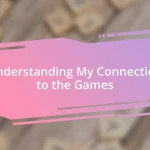Key takeaways:
- Icons transcend language and culture, providing universal communication and emotional connections.
- Personal experiences with specific icons reveal their power to inspire aspirations and evoke nostalgic memories.
- Visual literacy enhances understanding of icons, allowing deeper interpretations and sensitivity to cultural nuances.
![]()
Understanding the Role of Icons
Icons play a significant role in shaping our perceptions and guiding our decisions. I still remember the first time I encountered the iconic Apple logo. It was more than just a symbol; it felt like an invitation to creativity and innovation. Have you ever noticed how a simple image can evoke strong feelings and memories?
Consider how icons can transcend language and culture, creating a universal language of their own. When I traveled abroad, I often relied on symbols for directions and services. It amazed me how a quick glance at an icon could convey clarity and understanding, bridging the gaps where words sometimes fail. Isn’t it fascinating how these visual cues can help us navigate unfamiliar territories?
Moreover, I often reflect on how icons serve as emotional anchors in our lives. For instance, certain logos linked to my childhood still spark feelings of nostalgia and connection. This illustrates how icons can represent more than just brands; they can embody values, memories, and experiences. Have you felt that same connection with a symbol from your past?
![]()
Personal Experiences with Iconography
The impact of iconography in my life has been profound, especially when reflecting on my experiences in design. One particular moment stands out: I was sketching ideas for a community project when I stumbled upon the peace symbol. Instantly, it struck a chord with my desire for harmony and inclusivity. That simple design shifted my perspective, making me realize how deeply icons can inspire aspirations and shared values in our endeavors.
- As a child, the McDonald’s golden arches symbolized fun family outings, creating joyful associations.
- In university, the recycling symbol ignited my passion for sustainability, encouraging my commitment to environmental causes.
- More recently, I’ve found the inclusive rainbow flag to be a poignant reminder of the importance of acceptance and diversity in our communities.
![]()
How Icons Influence Perception
Icons hold a remarkable ability to shape our perceptions and influence our emotions. When I encountered the Nike swoosh for the first time, it wasn’t just a logo; it motivated me to push my limits. I can still feel the adrenaline surging through me as I laced up my sneakers, excited to channel that energy in my activities. Doesn’t it make you think about how a mere design can inspire such determination?
On another note, I find it interesting how icons can evoke collective memories. For example, the iconic “I ❤️ NY” logo brings back memories of my first trip to New York City, where the hustle and bustle of the streets felt electric. It also serves as a reminder of shared experiences between people who have visited the city, forging connections even without direct interaction. Isn’t there something almost magical about symbols that can encapsulate such powerful sentiments?
Furthermore, I can’t help but reflect on how icons can subtly change our perceptions of larger concepts. When I see the heart symbol, it instantly brings about feelings of love and compassion. This shift happens almost subconsciously; the visual cue primes me to think warmly about relationships and connections. Have you ever noticed how a simple icon can alter the way you approach a subject or idea?
| Element | Impact on Perception |
|---|---|
| Nike Swoosh | Inspires determination and motivation |
| I ❤️ NY | Evokes shared experiences and collective memories |
| Heart Symbol | Fosters feelings of love and compassion |
![]()
Visual Literacy and Icon Recognition
Visual literacy is an essential skill in today’s image-saturated world. I’ve discovered that the ability to interpret and understand icons can lead to deeper connections with both art and message. For example, when I first encountered the symbol for accessibility, it wasn’t just a marker for services; it struck me as a commitment to inclusivity. Have you ever considered how a single image can embody such an important value?
Recognizing icons goes beyond mere identification; it involves interpreting the deeper meanings embedded within them. I remember standing in front of a large mural showcasing various symbols of peace during a community art event. Each icon told a unique story, sparking conversations among viewers about their personal experiences with conflict and resolution. It made me ponder: How often do we overlook the stories that visuals can convey?
Moreover, I find that visual literacy enhances my sensitivity to cultural nuances. A simple symbol can differ greatly in meaning across contexts. For instance, while the dove is a universal icon of peace, in some cultures, it may represent something entirely different. This realization challenges me to think critically about my interpretations and influences the way I approach cross-cultural conversations. Have you thought about the layers of meaning behind the icons you encounter daily?













